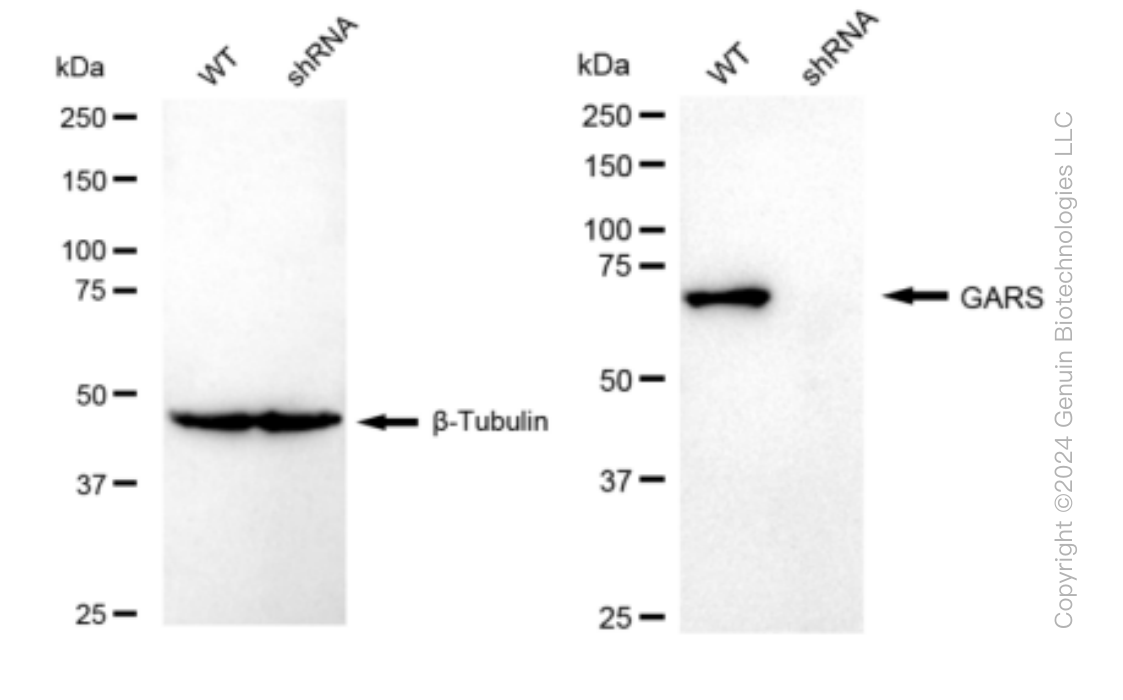KD-Validated Anti-GARS Rabbit Monoclonal Antibody
Rabbit monoclonal antibody
- SPECIFICATION
- CITATIONS
- PROTOCOLS
- BACKGROUND

Application
| WB |
|---|---|
| Primary Accession | P41250 |
| Reactivity | Rat, Human, Mouse |
| Clonality | Monoclonal |
| Isotype | Rabbit IgG |
| Clone Names | 23GB5515 |
| Calculated MW | Predicted, 83 kDa, observed, 75 kDa |
| Gene Name | GARS1 |
| Aliases | GARS1; Glycyl-TRNA Synthetase 1; GlyRS; DSMAV; SMAD1; GARS; Diadenosine Tetraphosphate Synthetase; Charcot-Marie-Tooth Neuropathy 2D; Glycyl-TRNA Synthetase; Glycine--TRNA Ligase; Ap4A Synthetase; EC 6.1.1.14; CMT2D; Charcot-Marie-Tooth Neuropathy, Neuronal Type, D; Glycine TRNA Ligase; AP-4-A Synthetase; EC 2.7.7.-; HMN5A; SMAJI; GLYRS; HMN5 |
| Immunogen | A synthesized peptide derived from human GARS |
| Gene ID | 2617 |
|---|---|
| Other Names | Glycine--tRNA ligase, 6.1.1.14, Diadenosine tetraphosphate synthetase, Ap4A synthetase, 2.7.7.-, Glycyl-tRNA synthetase, GlyRS, Glycyl-tRNA synthetase 1 {ECO:0000312|HGNC:HGNC:4162}, GARS1 (HGNC:4162), GARS |
| Name | GARS1 (HGNC:4162) |
|---|---|
| Synonyms | GARS |
| Function | Catalyzes the ATP-dependent ligation of glycine to the 3'-end of its cognate tRNA, via the formation of an aminoacyl-adenylate intermediate (Gly-AMP) (PubMed:17544401, PubMed:24898252, PubMed:28675565). Also produces diadenosine tetraphosphate (Ap4A), a universal pleiotropic signaling molecule needed for cell regulation pathways, by direct condensation of 2 ATPs. Thereby, may play a special role in Ap4A homeostasis (PubMed:19710017). |
| Cellular Location | Cytoplasm. Cell projection, axon. Secreted {ECO:0000250|UniProtKB:Q9CZD3}. Secreted, extracellular exosome {ECO:0000250|UniProtKB:Q9CZD3}. Note=In transfected COS7 cells, not detected in mitochondria, nor in Golgi apparatus (PubMed:17035524) Secreted by motor neuron, possibly through the exosome pathway (By similarity). {ECO:0000250|UniProtKB:Q9CZD3, ECO:0000269|PubMed:17035524} [Isoform 2]: Cytoplasm. Cell projection, axon |
| Tissue Location | Widely expressed, including in brain and spinal cord. [Isoform 1]: Expressed in brain, spinal cord, muscle, heart, spleen and liver. |

Thousands of laboratories across the world have published research that depended on the performance of antibodies from Abcepta to advance their research. Check out links to articles that cite our products in major peer-reviewed journals, organized by research category.
info@abcepta.com, and receive a free "I Love Antibodies" mug.
Provided below are standard protocols that you may find useful for product applications.
If you have used an Abcepta product and would like to share how it has performed, please click on the "Submit Review" button and provide the requested information. Our staff will examine and post your review and contact you if needed.
If you have any additional inquiries please email technical services at tech@abcepta.com.














 Foundational characteristics of cancer include proliferation, angiogenesis, migration, evasion of apoptosis, and cellular immortality. Find key markers for these cellular processes and antibodies to detect them.
Foundational characteristics of cancer include proliferation, angiogenesis, migration, evasion of apoptosis, and cellular immortality. Find key markers for these cellular processes and antibodies to detect them. The SUMOplot™ Analysis Program predicts and scores sumoylation sites in your protein. SUMOylation is a post-translational modification involved in various cellular processes, such as nuclear-cytosolic transport, transcriptional regulation, apoptosis, protein stability, response to stress, and progression through the cell cycle.
The SUMOplot™ Analysis Program predicts and scores sumoylation sites in your protein. SUMOylation is a post-translational modification involved in various cellular processes, such as nuclear-cytosolic transport, transcriptional regulation, apoptosis, protein stability, response to stress, and progression through the cell cycle. The Autophagy Receptor Motif Plotter predicts and scores autophagy receptor binding sites in your protein. Identifying proteins connected to this pathway is critical to understanding the role of autophagy in physiological as well as pathological processes such as development, differentiation, neurodegenerative diseases, stress, infection, and cancer.
The Autophagy Receptor Motif Plotter predicts and scores autophagy receptor binding sites in your protein. Identifying proteins connected to this pathway is critical to understanding the role of autophagy in physiological as well as pathological processes such as development, differentiation, neurodegenerative diseases, stress, infection, and cancer.



